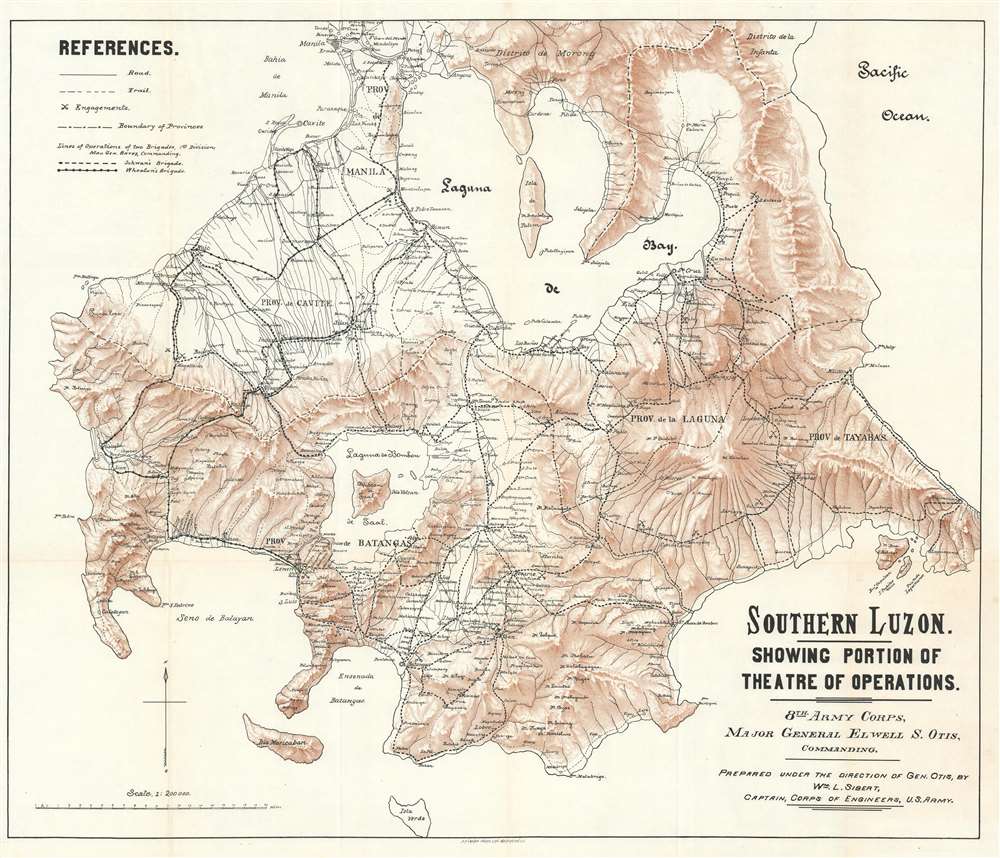
This item below is out of stock, but another example (left) is available. To view the available item, click "Details."
Details
1900 Otis Map of Southern Luzon, the Philippines - Philippine-American War
$950.00
1900 Otis Map of Southern Luzon, the Philippines - Philippine-American War
SouthernLuzon-otis-1900-2
Title
1900 (undated) 24 x 28.25 in (60.96 x 71.755 cm) 1 : 200000
Description
The Philippine-American War
The Philippine-American War lasted from February 4, 1899, until July 2, 1902, when the Philippine Organic Act established the Second Philippine Commission and Philippine legislature. The war immediately followed the Spanish-American War, once the Filipinos realized that the Americans were in the islands to stay. Estimates of Filipino civilian casualties vary wildly, from at least 200,000 to over one million, the majority of which were caused by famine and disease. Armed resistance to the U.S. occupation of the Philippines continued as a guerrilla insurrection in many parts of the archipelago until June 1913. The U.S. passed the Tydings-McDuffie Act, also known as the Philippine Independence Act, in 1934. This law created the Commonwealth of the Philippines, increased self-governance, and scheduled Philippine independence for 1944. World War II delayed this process, and the U.S. did not grant full independence to the Philippines until 1946.Publication History and Census
This map was prepared by William L. Sibert under the direction of Major General E. S. Otis. It was printed by A. B. Graham Photo Lithography of Washington D. C. Three examples are cataloged in OCLC and are part of the institutional collections at Michigan State University, the University of Chicago, and the University of California Davis.CartographerS
Andrew B. Graham (1845 - September 9, 1909) was an American lithographer active in Washington, D.C. in late 19th and early 20th century. Graham was born in Washington D.C., the son of a lithographer and engraver. After college, he joined the U.S. Coast Survey, where he was a draftsman until 1889. He retired from the Coast Survey to take over management of his father's lithography firm. The firm, Andrew B. Graham Company, was one of several that thrived on lucrative government publication contracts. Graham died of 'brain fever' in his Washington D. C. residence on September 9 of 1909. Some of his work was republished posthumously until about 1917, and his firm was active until at least the early 1920s. More by this mapmaker...
Elwell Stephen Otis (March 25, 1838 - October 21, 1909) was a United States army officer who served in the American Civil War, Indian Wars, the Philippines late in the Spanish-American War and during the Philippine-American War, where he commanded the Eighth Corps. He served following the Philippine-American War as the Military Governor General of the Philippines. While not popular in the Philippines due to his authoritarian and 'pompous' manner, he was a skilled and capable administrator. Otis was replaced in the Philippines by the more popular Douglas MacArthur in 1900. Otis died in Rochester, New York on October 21, 1909 from painful angina. Learn More...

